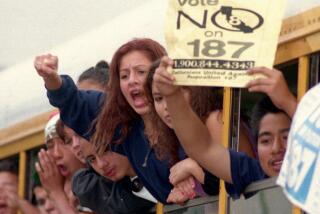CALIFORNIA ELECTIONS : Unflagging Controversy : Why did some protesters against Proposition 187 carry the red, white and green instead of the red, white and blue? To Latinos, it was prideful. To many Americans, it was insulting.
- Share via
It was a powerful campaign image: the red, white and green flags of Mexico, hoisted proudly over the heads of protesters making their stand against Proposition 187.
*
The flags were intended as a show of pride by people who felt their Mexican heritage under siege. Yet among non-Latino voters they were widely interpreted as a symbol of anti-American defiance, of suspicious allegiance to a foreign land--a lightning rod that dramatically increased emotional support for the measure.
On Wednesday, the groping for common ground continued on both sides of the cultural gulf.
“Why is it that so many people were upset by the sight of a Mexican flag?” wondered Latino activist Fabian Nunez. “It is just the expression of a search for identity . . . of cultural pride among a community that feels disenfranchised, but wants to integrate into the fabric of America. Nobody should be offended by that.”
But they were.
In the weeks leading up to Tuesday’s election, a rising tide of indignation registered on radio talk shows and in newspaper articles, as voters vented their anger over what they interpreted as a calculated spit in the eye.
“If they want to be part of this country, they should carry this country’s flag,” drugstore clerk Jarrod Holland complained to a reporter last week as he watched a cadre of Mexican-flag-waving students march through Woodland Hills.
On Wednesday, from the window of his flag factory on National Boulevard in West Los Angeles, Howard Furst watched protesters from Hamilton High School carrying Mexican flags aloft, and once again felt vindicated--and still angry.
“It pisses me off,” said the former Marine, who owns eight flag stores across Los Angeles County. “You see these kids walking down the street with a Mexican flag and demanding that this country give them a free education. . . . It aggravates people.”
“The biggest mistake the opposition made was waving those green and white flags with the snake on it,” said former Immigration and Naturalization Service Director Harold Ezell, who helped write Proposition 187. “They should have been waving the American flag.”
As Election Day neared, some Latino opposition leaders tried to minimize the impact of the foreign flags by passing out Old Glory at anti-187 demonstrations.
Still, the Mexican flags continued to wave.
Some were bought for the occasion at roadside swap meets. Others had been saved after last summer’s raucous World Cup festivities, or from recent celebrations surrounding the boxing victories by Mexican Julio Cesar Chavez--all by people who clung to the flag more as a family crest than a political weapon.
“Why should we carry American flags when this country wants to kick my friends out of school and send them back to Mexico?” demanded Mariela Flores, a 15-year-old Huntington Park sophomore who marched in two student walkouts. “We carry Mexican flags because they give us pride in where we come from.”
The Mexican flags were a “symbolic clinging to self-pride,” said Lloyd Monserratt, an aide to Los Angeles school board member Vicki Castro and confidant to some of the protesting students. “There was an acknowledgment that there may be a backlash, but much of this was just a spontaneous expression of pride.”
To many Californians, that pride felt like rejection.
“Flags are images that appeal directly to people’s emotions, and patriotism is a fairly deep bond that people feel,” said Brian Stonehill, who directs a media studies program at Pomona College in Claremont.
“The problem with waving the Mexican flag is while it rallied people of Mexican heritage, it alienated the mainstream American voter. It was like preaching to the converts instead of reaching across to address the mainstream, whose votes they needed.
“The Mexican flag may be fine for a sports event, like the World Cup, but they should not have chosen that symbol when they were preparing for an election. This is not like a sports event--it’s decided by the emotions of the people in the stands, not on the field. And those people in the stands felt their sense of national pride was being violated.”
UCLA professor David Hayes-Bautista, who heads the Center for the Study of Latino Health, reached even deeper for meaning.
“I think what these people were expressing is the desire to maintain the values that Latinos use to define themselves . . . their connection on a cultural level,” he said.
“When people are challenged as (the campaign for) Proposition 187 challenged the image of Latinos--with its TV ads showing them sneaking across the border in the dark--it pushes them in a corner, forces them to ask, ‘Who am I, really?’
“I can see why some of them would wrap themselves in the Mexican flag. An unfortunate choice of a symbol, maybe, but people should not misread it as a declaration of separation.”
Special correspondent Simon Romero contributed to this story.
More to Read
Get the L.A. Times Politics newsletter
Deeply reported insights into legislation, politics and policy from Sacramento, Washington and beyond. In your inbox twice per week.
You may occasionally receive promotional content from the Los Angeles Times.










